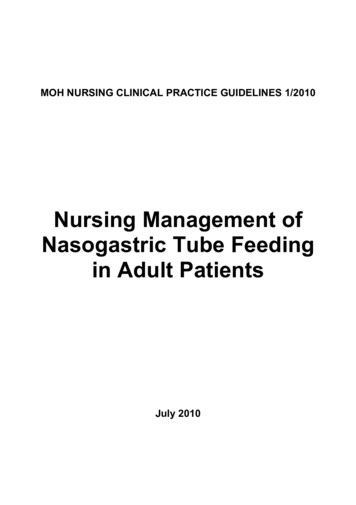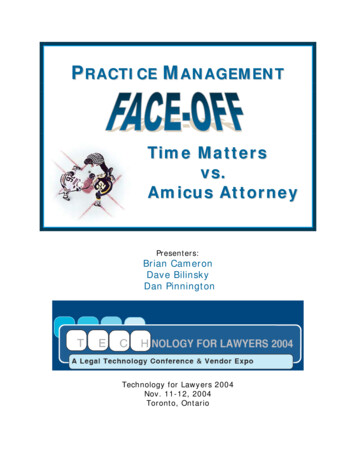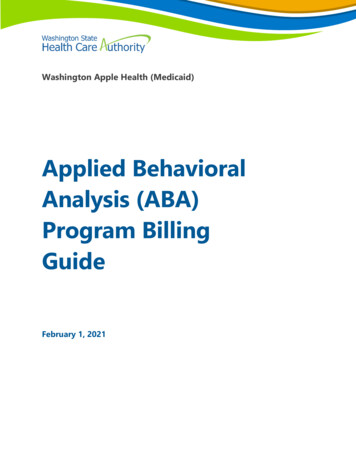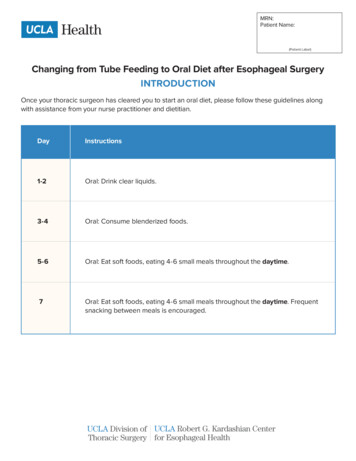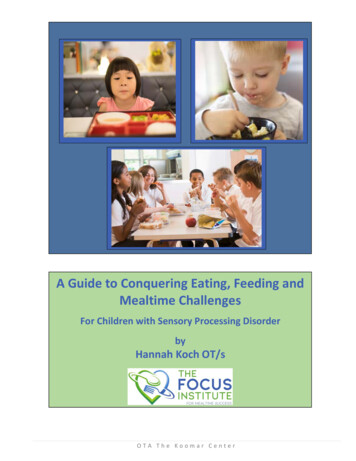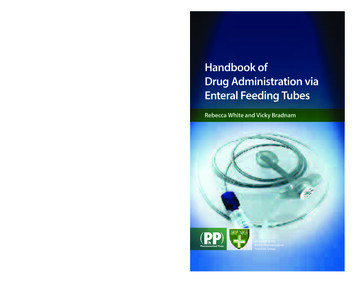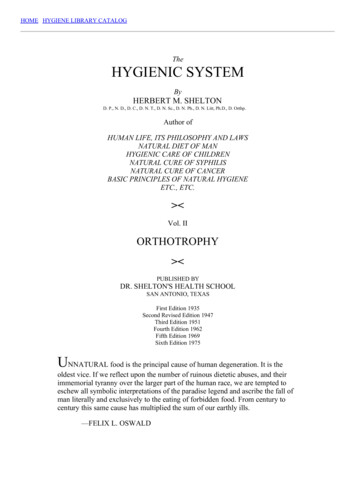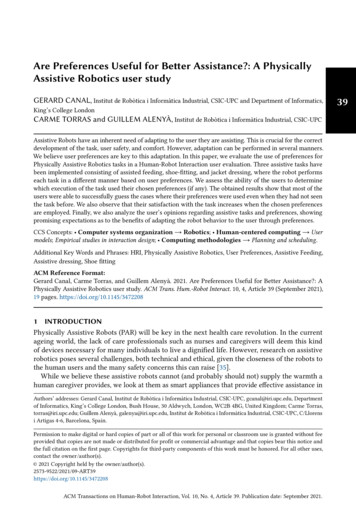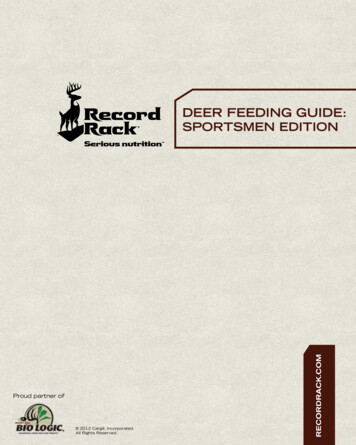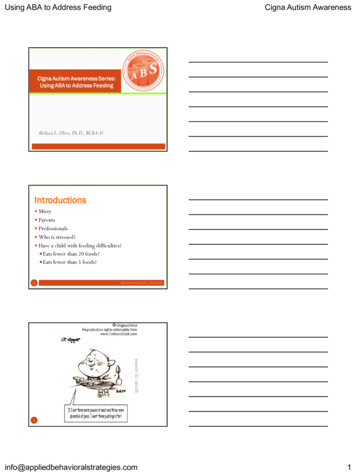
Transcription
Using ABA to Address FeedingCigna Autism AwarenessCigna Autism Awareness Series:Using ABA to Address FeedingMelissa L. Olive, Ph.D., BCBA-DIntroductions Missy Parents Professionals Who is stressed? Have a child with feeding difficulties? Eats fewer than 20 foods? Eats fewer than 5 foods?23Applied Behavioral StrategiesApplied Behavioral Strategiesinfo@appliedbehavioralstrategies.com1
Using ABA to Address FeedingCigna Autism AwarenessProfessionals:This workshop is insufficient toprepare you to offer feeding services.Parents: this workshop is insufficient to prepare youto address severe issues without support.Agenda Autism and feeding problems Necessary assessments before starting therapy Addressing feeding using ABA Funding for feeding therapy Additional resources Q &AApplied Behavioral Strategies5Autism and Eating Dr. Kanner’s original diagnostic criteria includedaberrant eating patterns (Kanner, 1943) 11 children with ASD 6 children with histories of severe feeding difficulties Case 1, Case 8, and Case 11 long-standing concernswith feeding Case 4 and Case 7 both vomited as infants Case 5 was tube fed6Applied Behavioral Strategiesinfo@appliedbehavioralstrategies.com2
Using ABA to Address FeedingCigna Autism AwarenessWhat Do We See? Extremely limited diet: chicken nuggets, gold fish, McD french fries The all white diet The crunchy salty diet Pureed only Grazes all day (rather than eat while sitting) Cannot bite off food Wants to be fed by an adult Only eats finger foods7Applied Behavioral Strategies8Applied Behavioral StrategiesLong Term Issues Associatedwith Feeding Problems Missed meals Malnourishment Failure to thrive or stunted growth Tube dependence We see this less and less because of things likepediasure Problematic mealtime behaviors9Applied Behavioral Strategiesinfo@appliedbehavioralstrategies.com3
Using ABA to Address FeedingCigna Autism AwarenessPediasure https://pediasure.com/ Ingredients:Water, Sugar, Corn Maltodextrin, Milk Protein Concentrate, High OleicSafflower Oil, Canola Oil, Whey Protein Concentrate. Less than 0.5% of theFollowing: Soy Protein Isolate, Short-Chain Fructooligosaccharides, Natural &Artificial Flavor, Cellulose Gel, Magnesium Phosphate, Potassium Chloride, PotassiumCitrate, Calcium Phosphate, Calcium Carbonate, Potassium Phosphate, Tuna Oil, Salt,Cellulose Gum, Choline Chloride, Ascorbic Acid, Soy Lecithin, Monoglycerides,Potassium Hydroxide, m-Inositol, Carrageenan, Taurine, Ferrous Sulfate, dl-AlphaTocopheryl Acetate, L-Carnitine, Zinc Sulfate, Calcium Pantothenate, Niacinamide,Manganese Sulfate, Thiamine Chloride Hydrochloride, Pyridoxine Hydrochloride,Riboflavin, Lutein, Cupric Sulfate, Vitamin A Palmitate, Folic Acid, ChromiumChloride, Biotin, Potassium Iodide, Sodium Selenate, Sodium Molybdate,Phylloquinone, Vitamin D3, and Cyanocobalamin.Applied Behavioral Strategies10Ingredients in Our Meals Clean protein (not processed, hormone free) Vegetable (not processed, fresh or frozen) Fruit (not processed, not sugared, fresh, or frozen Grain (whole grains, not processed, GF if needed, CFif needed)11Applied Behavioral StrategiesIssues Associated with FeedingProblems Added family stress12Applied Behavioral Strategiesinfo@appliedbehavioralstrategies.com4
Using ABA to Address FeedingCigna Autism AwarenessIs Feeding Intervention Warranted? Child height and weight Child skin color Food variety Meal time behaviors Parent Stress13Applied Behavioral StrategiesIs Feeding Intervention Warranted? Major cases require attention by experts and intensiveintervention Major feeding disorder Fewer than 30 total foods Limited textures Under height and/or weight Severe mealtime behavior (gagging, emesis,aggression, SIB)14Applied Behavioral StrategiesTypes of Feeding Disorders Physiological (Stevenson, 1995) Non-Physiological (Satter, 1990) Combination (Ramsay, 1995)15Applied Behavioral Strategiesinfo@appliedbehavioralstrategies.com5
Using ABA to Address FeedingCigna Autism erapyFBASpeechObtain foodObtain attnSpeechOTEscapeCombinedOTBehavioralApplied Behavioral Strategies16Assessment (Underlying Issues) Medical Allergic/Reactive Nutritional Deficiency Structural/MechanicalApplied Behavioral Strategies17GI Issues Children with autism have been shown to have GIissues GI treatment should follow standard medical protocol Some have said a unique GI condition exists amongchildren with autism GI Diseases Crohn’s, IBD, Colitis Reflux EE18Applied Behavioral Strategiesinfo@appliedbehavioralstrategies.com6
Using ABA to Address FeedingCigna Autism AwarenessConstipation We see too many children on Miralax (for life!) Miralax.com Polyethylene Glycol 3350 Other natural remedies are available Visit with your health care practitioner Fish oil Coconut oil Natural CalmApplied Behavioral Strategies19Food Allergies Celiac Disease Phenylketonuria (PKU) Maple Syrup SyndromeApplied Behavioral Strategies20Food Allergies/Food Reactions Allergists can assist here Physicians can assist with MRT MRT Testing MRT testing is helpful for food intolerance andsensitivity that is not caused by food allergies Reveals foods that may cause inflammation21Applied Behavioral Strategiesinfo@appliedbehavioralstrategies.com7
Using ABA to Address FeedingCigna Autism AwarenessNutritional Assessment Assess for deficiencies Zinc Calcium MagnesiumApplied Behavioral Strategies22Special Diets Children with ASD may be on special diets Special diets are for food intolerances or allergies Special diets may help children feel better which mayhelp them be ready to learn PKU, autism, cures .23Applied Behavioral StrategiesMost Common Food Allergens(mayoclinic.com) Milk Eggs Peanuts Tree nuts (such as almonds, cashews, walnuts) Fish (such as bass, cod, flounder) Shellfish (such as crab, lobster, shrimp) Soy Wheat24Applied Behavioral Strategiesinfo@appliedbehavioralstrategies.com8
Using ABA to Address FeedingCigna Autism AwarenessGFCF Gluten free and casein free Proteins believed to be intolerable Not limited to children with ASD Variations Soy free Corn free Rice free Nut freeApplied Behavioral Strategies25SCD(wikipedia.com) Specific Carbohydrate Diet Restricts the use of complex carbohydrates(disaccharides and polysaccharides) and eliminatesrefined sugar, gluten and starch from the diet Diet is promoted as a way of reducing the symptomsof irritable bowel syndrome, Crohn's disease,Ulcerative Colitis and autismApplied Behavioral Strategies26GAPS Diet The premise of the GAPS diet is that there is a correlation 27between the state of your intestinal flora and your brainchemistryAvoid foods on the do not eat list and repopulate the gut withgood bacteriaBone brothgood quality fateasily digested vegetablesboiled meatsfermented vegetable juiceApplied Behavioral Strategiesinfo@appliedbehavioralstrategies.com9
Using ABA to Address FeedingCigna Autism AwarenessStructural or Mechanical Assessment Speech Therapists and Occupational Therapists Swallow study Oral motor assessment Chewing ability Sensory processingApplied Behavioral Strategies28Behavior Assessment Determine the function of the feeding behaviors bycompleting FBA Most often:1. Escape non-preferred2. Obtain preferred3. Obtain attention Complete at least one Preference AssessmentApplied Behavioral Strategies29Behavior Intervention Plan (BIP) Modify the antecedents Teach a new behavior Most often communication Most often replaces problem behavior May be a new skill (independence) Modify consequences Change how you respond to junk behavior Reinforce the new behavior Reinforce appropriate behavior30Applied Behavioral Strategiesinfo@appliedbehavioralstrategies.com10
Using ABA to Address FeedingCigna Autism AwarenessBIP for Feeding Change antecedents Environment needs to be appropriate Child needs to be hungry Child needs to have a regular eating schedule—noquestions asked Teach a new behavior Reinforce And now for a scene from my feeding clinic31Applied Behavioral Strategies32Applied Behavioral StrategiesAntecedent Modifications1. Prepare for Difficult Times2. Positive Feeding Environment3. Clear Meal Time Rules4. Novel foods are presented in small portions usingDiscrete Trial Training (DTT)5. Establishing Operations33Applied Behavioral Strategiesinfo@appliedbehavioralstrategies.com11
Using ABA to Address FeedingCigna Autism Awareness1. Prepare for Difficult Times Family Stress Identify reinforcers for family Prepare families for what is to come Child Stress Depending on age of child, prepare child Therapist Training CPR Challenging Behavior Prepare for stress34Applied Behavioral Strategies2. Positive Feeding Environment Appropriate Seating35Applied Behavioral Strategies36info@appliedbehavioralstrategies.com12
Using ABA to Address FeedingCigna Autism Awareness37Appropriate Utensils38Appropriate Cups39info@appliedbehavioralstrategies.com13
Using ABA to Address FeedingCigna Autism AwarenessAppropriate Dishes404142info@appliedbehavioralstrategies.com14
Using ABA to Address FeedingCigna Autism Awareness43443. Clear Meal Time Rules Sitting for all meals Appropriate table manners Use utensils Use napkin No eating off table No licking dishes Done is done45Applied Behavioral Strategiesinfo@appliedbehavioralstrategies.com15
Using ABA to Address FeedingCigna Autism Awareness4. Novel Food Presentation Discrete Trial Training Antecedent, Behavior, Consequence Take a bite, child eats bite, child receivesreinforcement How do you try new foods?Applied Behavioral Strategies465. Establishing Operations Hunger Inducement Consistent meal time No food 2 hours before or after intervention Limit liquid consumption Reinforcer Deprivation Limit access to planned reinforcer for at least 1week before intensive interventionApplied Behavioral Strategies47Why is this step important?Why doesn’t it work on its own?Why can’t parents allow their child to get hungry?Withdrawal symptoms48Applied Behavioral Strategiesinfo@appliedbehavioralstrategies.com16
Using ABA to Address FeedingCigna Autism AwarenessTarget Behaviors Accepting novel foods Eating with a Drinking from a Sitting during meal time Coming to table when calledApplied Behavioral Strategies49Instructional Techniques Shaping Modeling Prompting and prompt fading Size fadingApplied Behavioral Strategies50Shape Acceptance of New Food This intervention is a well-established intervention inthe feeding literature (Kerwin, 1999) Introduce new food one bite at a time Variations of “acceptance”51Applied Behavioral Strategiesinfo@appliedbehavioralstrategies.com17
Using ABA to Address FeedingCigna Autism AwarenessModel Live model of each shaping step Yes, model how to appropriately spit food out Use trash can as an SD for spitting52Applied Behavioral StrategiesPrompt Physically prompt child to pick up utensil Physically prompt to move bite towards mouth53Applied Behavioral StrategiesPrompt Fading Fade physical prompts Touch wrist Tap utensil Open mouth Tap plate Point to plate54Applied Behavioral Strategiesinfo@appliedbehavioralstrategies.com18
Using ABA to Address FeedingCigna Autism AwarenessSize Fading Regular child size bite Touch lip Touch tongue In mouth and spit Microscopic bite (one green pea or smaller) Chew and spit Chew and swallow55Applied Behavioral StrategiesAdult Bite Size56Applied Behavioral StrategiesChild Bite Size57Applied Behavioral Strategiesinfo@appliedbehavioralstrategies.com19
Using ABA to Address FeedingCigna Autism AwarenessTexture Fading Puree Finely chopped Chopped Bite Size58Applied Behavioral StrategiesModify Consequences Reinforce food acceptance using shaping protocol1. DRA2. Sequential reinforcement3. Simultaneous reinforcement4. Negative reinforcement Escape Extinction59Applied Behavioral StrategiesDRA Reinforce acceptance on FR:1 Yes, reinforce 30 seconds for each trial Quickly modify the schedule of reinforcement60Applied Behavioral Strategiesinfo@appliedbehavioralstrategies.com20
Using ABA to Address FeedingCigna Autism AwarenessDRA: Note Easier to use reinforcer that: May be accessed at the table Has an easy stop and start Is controlled by an adult (e.g., remote) Great success with iPhone and iPad Cupcakes, pizza, toast Wheels on the bus, Itsy Bitsy Spider Wooden puzzles You Tube Other movies61Applied Behavioral StrategiesAttention as a Reinforcer This intervention is well established in the feedingliterature (Kerwin, 1999) Food intake increases, weight gain observed, andresults maintain When child accepts food, positive attention is given Yay! You took a bite! Yummy bananas! Big girl eating peas!Applied Behavioral Strategies62Sequential Reinforcement When child engages in desired feeding behavior,provide access to highly preferred food Quickly modify the schedule of reinforcement Require more bites of non-preferred Provide smaller bites of preferred63Applied Behavioral Strategiesinfo@appliedbehavioralstrategies.com21
Using ABA to Address FeedingCigna Autism AwarenessSimultaneous Reinforcement Mix preferred food with non-preferred foods Do not hide food Examples: Raw veggies (non-preferred) dipped in hummus (highlypreferred) Veggies (non-preferred) on pizze (highly preferred) Chips (highly preferred) dipped in guacamole (nonpreferred)Applied Behavioral Strategies64Negative Reinforcement Allow 30 second break from the table contingent onbite acceptance Usually difficult to get child backApplied Behavioral Strategies65Escape Extinction 66Child does not get out of trying new foodNon-removal of the spoon/fork/utensilWell established interventionApplied Behavioral Strategiesinfo@appliedbehavioralstrategies.com22
Using ABA to Address FeedingCigna Autism AwarenessOn-Going Therapy If you treat within an on-going ABA program Child already responds to ABA Child has positive experience with team Can be a program just like putting on shoes Advantages Much less stressful for everyone Baby steps are achieved Can work on it every day (or every therapy session)Applied Behavioral Strategies67On-Going Therapy Disadvantages Baby steps Slow progress What if child has weight issue?Applied Behavioral Strategies68Intensive Therapy Requires Planning Preparation Advantages Extremely effective Very quick results Parents see effectiveness Long-term maintenance69Applied Behavioral Strategiesinfo@appliedbehavioralstrategies.com23
Using ABA to Address FeedingCigna Autism AwarenessIntensive Therapy Disadvantages Extremely stressful Extremely difficult behaviors Severe food withdrawals in a few situations A parent withdrew once One parent wanted to quit Does not work if parents are not on board Does not work if parents are not behavioral or ifthey don’t want to hear their child cryApplied Behavioral Strategies70Data Collection Total Bites Presented Independent Bites (accepted within 5 seconds) Prompted Bites Consumed Bites Expelled Bites Type of food Challenging Behavior Gag, Emesis, Aggression, Disruption, SIB, Cry, Verbal,Vocal, Other delayApplied Behavioral Strategies71Funding Insurance Autism coverage in some states If no disability then only approved by SLP or OT IEP/IFSP Functional skill Affects education Grants State DD centers Non-profits72Applied Behavioral Strategiesinfo@appliedbehavioralstrategies.com24
Using ABA to Address FeedingCigna Autism AwarenessSummary Rule out underlying issues Assess function of behavior Modify antecedents (prepare and plan) Reinforce acceptance combined with shaping Intensity matters73Applied Behavioral Strategies74Applied Behavioral ) 903-9363info@appliedbehavioralstrategies.com25
Using ABA to Address FeedingCigna Autism AwarenessResources Finding a good GI doc Finding a good SLP or OT Other Behavioral Feeding Resources Clinic 4 Kidz CARD Feeding Clinics Marcus Institute Kennedy Krieger University of Nebraska76Applied Behavioral Strategiesinfo@appliedbehavioralstrategies.com26
Specific Carbohydrate Diet Restricts the use of complex carbohydrates (disaccharides and polysaccharides) and eliminates refined sugar, gluten and starch from the diet Diet is promoted as a way of reducing the symptoms of irritable bowel syndrome, Crohn's disease, Ulcerative Colitis and autism 26 Applied Behavioral Strategies GAPS Diet
